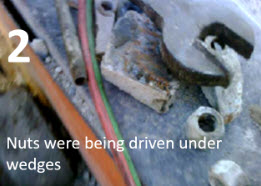Choosing the Right Rock Crushing Equipment
Stone crushing can be classified into four stages depending on the degree to which the starting material is fragmented. These four stages are...

There are many reasons why your impact crusher blow bars are breaking on a regular basis. We have compiled a list of the most common causes of blow bar failure and the solutions to those problems.
Notice the gap shown by the left arrow. The blow bar is supposed to be flush with this surface, driven by a wedge. The direction is shown by the right arrow.

Possible Causes:
This customer experienced multiple breakages at the point where the rotor was worn and had a crack. This rotor needs to be replaced or rebuilt.

If a replacement or rebuild is not practical, moving to Manganese blow bars will help.
Problem:
The customer was experiencing breakage. When we went to the site, we found that the wedges were loose, causing the bar to move up in the rotor station, causing pressure on the locating nose. This pressure lead to a break in a blow bar. A new person was in charge of the crusher and did not realize they could loosen.

Solution:
A program was initiated to check wedge tightness a few hours after new blow bars were installed and at other intervals.
Are the wedges tightened properly? What is the condition of the wedges?
Are they being checked periodically for tightness, especially after initial installation?
Image 1 & 2
Here is an example of wedges not being used properly; user was forcing old nuts/bolts under wedges to push them up instead of jacking bolts/ set screws. These wedges need to be replaced with new ones!
 |
 |
Image 3
Another example of breakage due to the insufficient support of the blow bar. Notice how the wedge & rotor is worn down, so it only contacts the bar properly at the bottom.

.jpg)
Stone crushing can be classified into four stages depending on the degree to which the starting material is fragmented. These four stages are...

1. Choose Machined Blow Bars Image #1An image of well-machined blow bars from AMCAST.

Cobalt, a blue-gray metallic element, atomic number 27 on the periodic table of elements, is utilized in a variety of everyday applications such as...